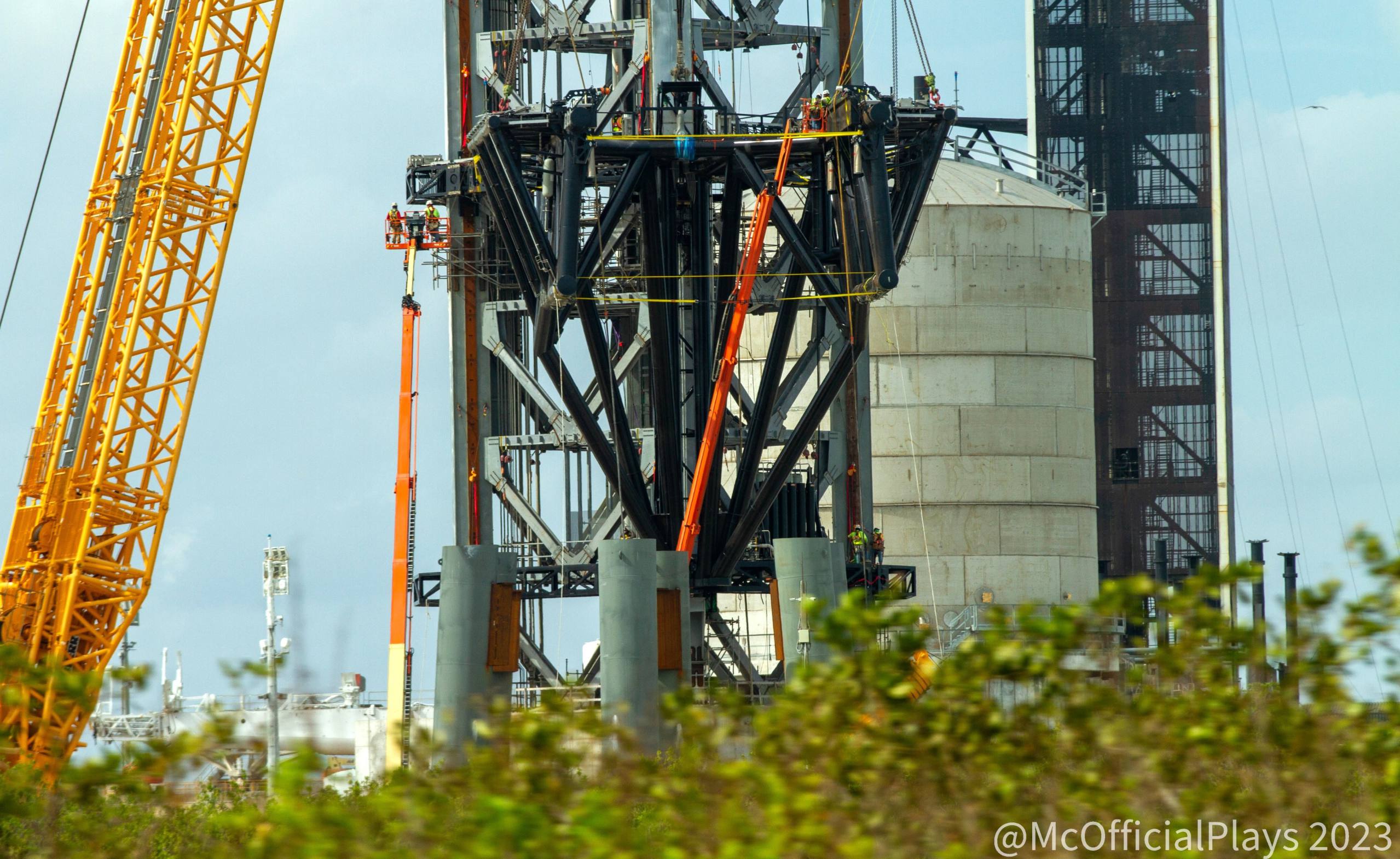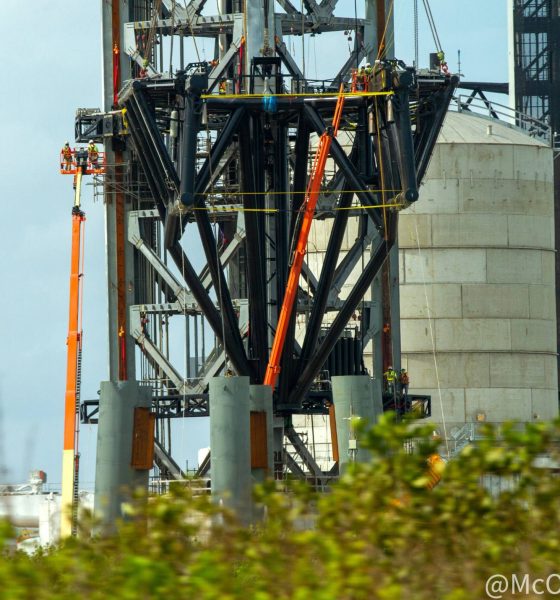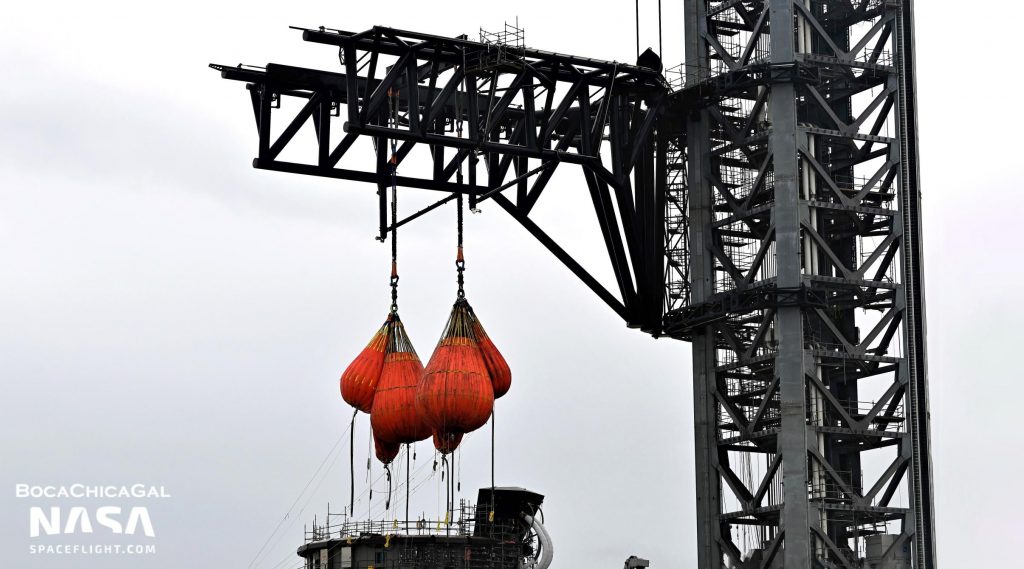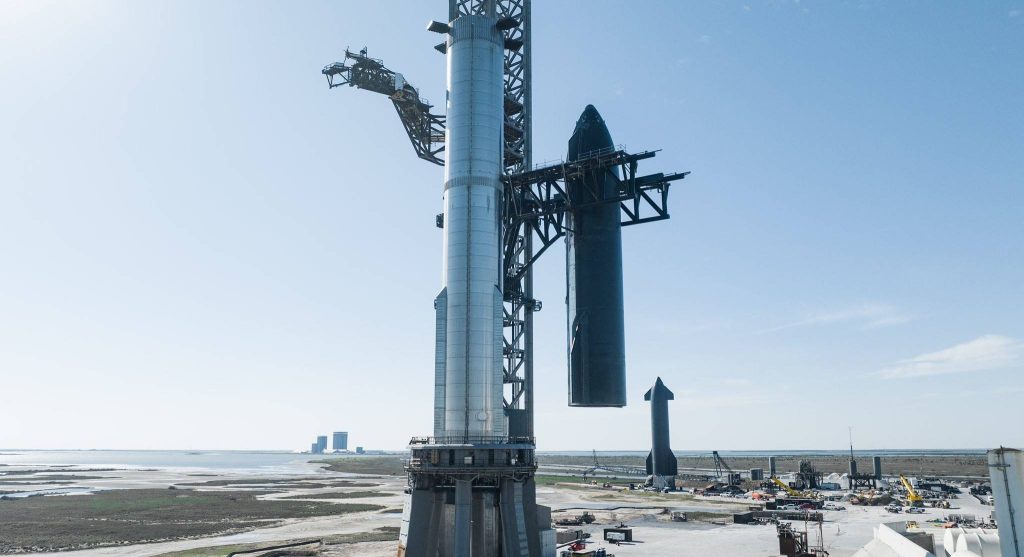

News
SpaceX installs rocket-catching arms on Starship’s Florida launch tower
SpaceX has installed a pair of rocket-catching arms on a tower meant to support the first East Coast launches of its next-generation Starship rocket.
The company has been building the second of several planned Starship launch sites for more than three years. Ironically, work on that pad began before the company started building the pad that will actually support Starship’s first orbital launch attempts. Located a stone’s throw from the Gulf of Mexico in Boca Chica, Texas, the first iteration of SpaceX’s Starbase orbital launch site (OLS) is nearly complete and could host Starship’s orbital launch debut in a matter of months. SpaceX began constructing Starship’s Texas launch site in earnest in late 2020.
SpaceX broke ground on Starship’s first Florida OLS in late 2019. But the company went on to radically redesign the rocket and its ground systems, forcing it to entirely abandon about a year of work by the end of 2020. In late 2021, SpaceX finally began constructing the second iteration of Starship’s first Florida pad. OLS #2 is still colocated at Kennedy Space Center’s LC-39A pad, which SpaceX leases from NASA. Pad 39A is the only site currently capable of launching SpaceX’s Crew Dragon astronaut spacecraft or Falcon Heavy rocket, which has complicated its plans to use the same pad for Starship.
The update that's rolling out to the fleet makes full use of the front and rear steering travel to minimize turning circle. In this case a reduction of 1.6 feet just over the air— Wes (@wmorrill3) April 16, 2024
Because of NASA’s trepidation at the thought of a Starship failure indefinitely delaying SpaceX from completing its Crew Dragon or Falcon Heavy contracts for the agency, the company deprioritized Starship’s Florida pad, slowing progress. SpaceX has, nonetheless, made significant progress. In 13 months, SpaceX has created foundations, modified one of Pad 39A’s giant spherical tanks to store cryogenic methane, installed miles of plumbing, built and assembled a second skyscraper-sized Starship launch tower, installed the legs of the pad’s ‘orbital launch mount’ or OLM, installed a water deluge system at the base of the OLM, assembled most of the OLM’s donut-like mount offsite, constructed a new supersized storage tank, and delivered a forest of smaller storage tanks.
Most recently, SpaceX finished building a giant pair of steel arms, transported the arms to Pad 39A, attached them to a wheeled carriage, and installed the structure on Starship’s Florida launch tower. SpaceX employees have nicknamed the arms “chopsticks,” and those arms are integral to what CEO Elon Musk calls “Mechazilla”. Mechazilla refers to the combined launch tower and arms, which SpaceX has designed to grab, lift, stack, and fuel both stages of Starship.
Mechazilla’s simplest part is a third arm that is vertically fixed in place but capable of swinging left and right. The swing arm contains plumbing and an umbilical device that connects to Starship’s upper stage and supplies propellant, gas, power, and connectivity. The tower’s ‘chopsticks’ are far more complex. Giant hinges connect the pair of arms to a carriage that grabs onto three of the tower’s four legs with a dozen skate-like appendages. Those skates are outfitted with wheels, allowing the carriage to roll up and down tracks built into the tower’s legs.



The carriage, which also carries the complex hydraulic systems that allow its bus-sized arms to move, is connected by steel cable to a heavy-duty “draw works” capable of hoisting the multi-hundred-ton assembly up and down the tower. Once finished, the Florida tower’s arms will be able to precisely lift, maneuver, stack, and de-stack Starship and Super Heavy even in relatively windy conditions. At some point in the future, SpaceX may attempt to use its towers and chopsticks to catch Starships and Super Heavies out of mid-air and speed up reuse.
Set to be the largest, most powerful, and most capable rocket in history, Starship is primarily built out of steel and designed to be fully reusable. SpaceX has a long way to go to demonstrate that the 120-meter-tall (~390 ft) rocket can reach orbit, let alone be reused. In theory, though, Starship is meant to launch up to 150 metric tons (330,000 lb) to low Earth orbit (LEO) while still allowing for the recovery and reuse of its suborbital Super Heavy booster and orbital Starship upper stage.
If SpaceX can achieve those figures, Starship will be the most capable rocket in history even with the major performance penalties that full reusability entails. Saturn V, the most capable rocket ever flown, was fully expendable and could launch up to 118 metric tons (~260,000 lb) into orbit.
Due to NASA’s concerns about the risks that Starship launches from Pad 39A could pose to SpaceX’s Falcon and Dragon operations at the same site, the company’s next-generation rocket may have to wait until 2024 or 2025 for its first Florida launch. With the first Florida Mechazilla now close to completion, it’s likely that Pad 39A’s Starship launch site will be ready and waiting as soon as NASA gives SpaceX the green light.

News
Waymo scrutinized after self-driving taxis cause traffic jams during SF blackout
It’s not farfetched to speculate that it would have been a doomsday scenario for Tesla had FSD behaved this way.

A power outage across San Francisco over the weekend forced numerous Waymo self-driving taxis to stop at darkened intersections and cause traffic blockages in multiple locations across the city. The disruption left riders stranded, frustrated drivers blocked, and city officials stepping in as the Alphabet-owned company temporarily suspended service amid the widespread gridlock.
Needless to say, it would likely have been a doomsday scenario for Tesla had FSD behaved in a similar way, especially if fleets of its robotaxis blocked traffic for numerous drivers.
Power outage halts Waymo fleet
The outage knocked out electricity for tens of thousands of customers, leaving traffic signals dark across large parts of the city, as noted in a report from the New York Times. Waymo vehicles began stopping at intersections and remained stationary for extended periods, seemingly unable to operate. Tow truck operators worked through the night removing immobilized vehicles, while videos circulated online showing Waymos with hazard lights flashing as traffic backed up around them.
Waymo later confirmed that it had paused its Bay Area ride-hailing service after the San Francisco mayor’s office contacted the company about the congestion its vehicles were contributing to. Service began coming back online shortly after 3:30 p.m. local time, though some users still reported being unable to request rides. Waymo maintained that no injuries or accidents were reported during the outage.
Autonomous cars during emergencies
The incident surprised industry observers since autonomous vehicles are designed to function during signal outages and temporary connectivity losses. Waymo stated that its vehicles treat nonfunctional signals as four-way stops, but “the sheer scale of the outage led to instances where vehicles remained stationary longer than usual to confirm the state of the affected intersections. This contributed to traffic friction during the height of the congestion.” Experts suggested the problem may have been linked to the vehicles’ reliance on remote assistance teams, which help resolve complex situations the cars cannot handle independently.
“Yesterday’s power outage was a widespread event that caused gridlock across San Francisco, with non-functioning traffic signals and transit disruptions. While the failure of the utility infrastructure was significant, we are committed to ensuring our technology adjusts to traffic flow during such events,” the Waymo spokesperson stated, adding that it is “focused on rapidly integrating the lessons learned from this event, and are committed to earning and maintaining the trust of the communities we serve every day.”
News
Tesla aims to combat common Full Self-Driving problem with new patent
Tesla writes in the patent that its autonomous and semi-autonomous vehicles are heavily reliant on camera systems to navigate and interact with their environment.

Tesla is aiming to combat a common Full Self-Driving problem with a new patent.
One issue with Tesla’s vision-based approach is that sunlight glare can become a troublesome element of everyday travel. Full Self-Driving is certainly an amazing technology, but there are still things Tesla is aiming to figure out with its development.
Unfortunately, it is extremely difficult to get around this issue, and even humans need ways to combat it when they’re driving, as we commonly use sunglasses or sun visors to give us better visibility.
Cameras obviously do not have these ways to fight sunglare, but a new patent Tesla recently had published aims to fight this through a “glare shield.”
Tesla writes in the patent that its autonomous and semi-autonomous vehicles are heavily reliant on camera systems to navigate and interact with their environment.

The ability to see surroundings is crucial for accurate performance, and glare is one element of interference that has yet to be confronted.
Tesla described the patent, which will utilize “a textured surface composed of an array of micro-cones, or cone-shaped formations, which serve to scatter incident light in various directions, thereby reducing glare and improving camera vision.”

The patent was first spotted by Not a Tesla App.
The design of the micro-cones is the first element of the puzzle to fight the excess glare. The patent says they are “optimized in size, angle, and orientation to minimize Total Hemispherical Reflectance (THR) and reflection penalty, enhancing the camera’s ability to accurately interpret visual data.”
Additionally, there is an electromechanical system for dynamic orientation adjustment, which will allow the micro-cones to move based on the angle of external light sources.
This is not the only thing Tesla is mulling to resolve issues with sunlight glare, as it has also worked on two other ways to combat the problem. One thing the company has discussed is a direct photon count.
CEO Elon Musk said during the Q2 Earnings Call:
“We use an approach which is direct photon count. When you see a processed image, so the image that goes from the sort of photon counter — the silicon photon counter — that then goes through a digital signal processor or image signal processor, that’s normally what happens. And then the image that you see looks all washed out, because if you point the camera at the sun, the post-processing of the photon counting washes things out.”
Future Hardware iterations, like Hardware 5 and Hardware 6, could also integrate better solutions for the sunglare issue, such as neutral density filters or heated lenses, aiming to solve glare more effectively.
Elon Musk
Delaware Supreme Court reinstates Elon Musk’s 2018 Tesla CEO pay package
The unanimous decision criticized the prior total rescission as “improper and inequitable,” arguing that it left Musk uncompensated for six years of transformative leadership at Tesla.

The Delaware Supreme Court has overturned a lower court ruling, reinstating Elon Musk’s 2018 compensation package originally valued at $56 billion but now worth approximately $139 billion due to Tesla’s soaring stock price.
The unanimous decision criticized the prior total rescission as “improper and inequitable,” arguing that it left Musk uncompensated for six years of transformative leadership at Tesla. Musk quickly celebrated the outcome on X, stating that he felt “vindicated.” He also shared his gratitude to TSLA shareholders.
Delaware Supreme Court makes a decision
In a 49-page ruling Friday, the Delaware Supreme Court reversed Chancellor Kathaleen McCormick’s 2024 decision that voided the 2018 package over alleged board conflicts and inadequate shareholder disclosures. The high court acknowledged varying views on liability but agreed rescission was excessive, stating it “leaves Musk uncompensated for his time and efforts over a period of six years.”
The 2018 plan granted Musk options on about 304 million shares upon hitting aggressive milestones, all of which were achieved ahead of time. Shareholders overwhelmingly approved it initially in 2018 and ratified it once again in 2024 after the Delaware lower court struck it down. The case against Musk’s 2018 pay package was filed by plaintiff Richard Tornetta, who held just nine shares when the compensation plan was approved.
A hard-fought victory
As noted in a Reuters report, Tesla’s win avoids a potential $26 billion earnings hit from replacing the award at current prices. Tesla, now Texas-incorporated, had hedged with interim plans, including a November 2025 shareholder-approved package potentially worth $878 billion tied to Robotaxi and Optimus goals and other extremely aggressive operational milestones.
The saga surrounding Elon Musk’s 2018 pay package ultimately damaged Delaware’s corporate appeal, prompting a number of high-profile firms, such as Dropbox, Roblox, Trade Desk, and Coinbase, to follow Tesla’s exodus out of the state. What added more fuel to the issue was the fact that Tornetta’s legal team, following the lower court’s 2024 decision, demanded a fee request of more than $5.1 billion worth of TSLA stock, which was equal to an hourly rate of over $200,000.
Delaware Supreme Court Elon Musk 2018 Pay Package by Simon Alvarez








